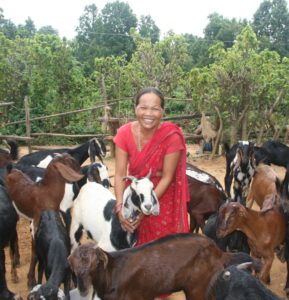In this blog, Alex Russell of the Feed the Future Innovation Lab for Assets and Market Access describes the Heifer International SLVC program, a program intended to help poor rural women in Nepal create a sustainable pathway out of poverty. As part of their impact evaluation, the program piloted the project-level Women's Empowerment in Agriculture Index as part of the Gender, Agriculture, and Assets Project, Phase 2.
Women’s empowerment can be challenging to measure, and even more challenging to compare across different countries and regions, or even different communities. An objective measure based on high-quality—and consistent—indicators could be used to apply lessons learned on promoting women’s empowerment from one project to the next.
In 2014, a Feed the Future Innovation Lab for Assets and Market Access research team launched a study to evaluate the impacts of a Heifer International livelihoods program in Nepal. The project in Nepal was a nearly ideal setting to help pilot the International Food Policy Research Institute’s project-level Women’s Empowerment in Agriculture Index (pro-WEAI).
The Heifer International SLVC program is intended to help poor rural women create a sustainable pathway out of poverty. The program forms self-help groups through which women receive trainings on animal husbandry and a series of values-based trainings. Each participant receives two female goats and each group is given a buck of improved breeding stock. The groups are also required to “pass on the gift” by recruiting other women to receive the same trainings and providing them a goat.
The program seeks to promote empowerment through various pathways, including increasing women’s ownership and decision-making over these new productive assets, the goats. The community-building and values-based trainings were both designed to promote women’s empowerment, but it can be a challenge to separate how each component affects measurable indicators of women’s empowerment.
“Heifer tries to do more than increase household income; they also seek to empower women,” said Sarah Janzen, an assistant professor of agricultural economics at Kansas State University and principal investigator on the study. “Our evaluation is designed to measure if greater empowerment comes from having access to a new income-generating asset, improved technical or entrepreneurial skills, greater social capital, or from trainings designed specifically with empowerment in mind.”
The Women’s Empowerment in Agriculture Index (WEAI) was developed by a research collaboration led by the International Food Policy Research Institute and commissioned by Feed the Future. It is a survey-based index designed to measure the empowerment, agency, and inclusion of women in the agricultural sector.
Before WEAI, studies of women’s empowerment used national data and focused on numbers like the proportion of women in parliament or education, said Ruth Meinzen-Dick, an IFPRI sociologist who helped develop WEAI. “None of the indicators directly applied to women in agriculture,” said Meinzen-Dick.
The AMA Innovation Lab study in Nepal was one of the first projects included in the development of pro-WEAI, a version of WEAI designed for field evaluations of projects focused on women’s empowerment. Meinzen-Dick said that the project’s use of pro-WEAI has already provided a new understanding of women’s empowerment in general.
One of these lessons is that a women’s position in the household matters. Whether a woman is a wife or daughter-in-law and the household’s broader lifecycle all help to determine her levels of empowerment.
“The qualitative has helped us to develop indicators that are grounded in the local context and that also help us to understand how do people, both women and men, see a project as affecting their lives and livelihoods,” said Meinzen-Dick.
In this way, pro-WEAI is also a tool to build more general knowledge of women’s empowerment around the world. This is possible because the pro-WEAI survey modules are largely uniform from project to project. This means researchers can compare indicators of women’s empowerment in widely different settings.
This could be particularly valuable for nutrition interventions. Though it was not used in the Nepal study, pro-WEAI has a nutrition module that comes in two parts. One measures nutritional status with standard indicators like stunting or wasting. The other part measures how empowered women are to make nutrition-related decisions for themselves and the household.
“If mothers, for example, don’t actually have the ability to make decisions about nutritious foods, then the behavior change communication about food choices directed to women isn’t as valuable,” says Meinzen-Dick.
From the study in Nepal, the research team reported primary results in an AMA Innovation Lab policy brief in April 2017. Women who participated in Heifer International’s SLVC program experienced greater rates of financial inclusion and empowerment compared to women who did not. The program had similar impacts for women who had been recruited as part of passing on the gift.
Janzen says that when she and her team met with women in the study, she asked about the biggest change they had experienced since being in a Heifer women’s group. The response was the same in every group. The women got really quiet. Then they said that before joining the group they couldn’t introduce themselves, meaning that they couldn’t stand up in front of someone and say hello.
“When you talk to women in these groups,” said Nick Magnan, an associate professor of agricultural economics at the University of Georgia and another principle investigator of the study, “they feel empowered in their home and community, part of something, speaking in a group, speaking in public. Our data really bear out the same story.”
Learn more about the Feed the Future Innovation Lab for Assets and Market Access at https://basis.ucdavis.edu.
